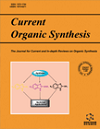- Home
- A-Z Publications
- Current Organic Synthesis
- Issue Home
Current Organic Synthesis - Current Issue
Volume 22, Issue 3, 2025
-
-
Advances in the Total Synthesis of Pharmacologically Important Fused Indolizidine Alkaloids: Securinine, Gephyrotoxin and Lepadiformine
More LessAuthors: Afiqah A.A. Ali, Agustono Wibowo, Nor H.M. Rosli, Jhi B. Foo, Mohd F. Mohammat and Jason S.E. LooIndolizidine alkaloids represent a diverse group of naturally occurring compounds which are derived from various sources and possess a wide range of pharmacological activities. Fused indolizidine alkaloids represent a distinct subset of these compounds, where additional rings are fused with the indolizidine core. When combined with the specific stereochemistry typically required for their biological activity, the fused ring structure Read More
-
-
-
A Pharmacological Overview and Recent Patent of Triazine Scaffold in Drug Development: A Review
More LessAuthors: Pragya Dubey, Dharam Pal Pathak, Garima Chauhan and Faraat AliThe triazine moiety holds a special and very important position in the field of medicinal chemistry owing to its enormous biological and pharmacological potential. Over eras, triazine scaffolds have been investigated for synthesizing novel molecules that may be used for the treatment of different types of pathological conditions, such as infections, cancer, inflammation etc. A vast number of lead molecules ha Read More
-
-
-
3-Acetyl Indole in the Synthesis of Natural Bioactive Compounds
More LessAuthors: Eslam R. El-Sawy, Mohamed S. Abdel-Aziz and Gilbert KirschNatural products, with their various sources from plants, marine organisms, and microorganisms, are considered a key source and inspiration for medicines and continue to be so. Indole alkaloids are a class of alkaloids and represent a large subunit of natural products. Indole alkaloids of biological importance are numerous and cover a wide range of pharmaceutical applications, including anticancer, antiviral, antimicrobia Read More
-
-
-
Changes in Germination Parameters, Growth and Development of Three Cultivars of Corn Seedlings under Various Aqueous Extracts of Mallow
More LessAuthors: Mehdi Khoshkharam, Mohamad Hesam Shahrajabian and Wenli SunIntroductionAllelopathy related to a positive or negative impacts on one type of plant, by a chemical produced by another type of plant such as weeds, and different kinds of chemicals are hydroxamic acids, phenolics, and short-chain fatty acids. The potential allelopathic impacts of weeds is directly associated to the plan species used, as well as to the concentration of the aqueous extract available in the environment.Method Read More
-
-
-
Synthesis and Characterization of Novel Polythiadiazoles from Bis-hydrazonoyl Dichlorides and Bis-(methyl-2-arylidene Hydrazone Carbodithioates)
More LessAuthors: Abdelwahed R. Sayed and Jeffrey S. WigginsBackgroundThiadiazoles exhibit a variety of biological activities, including antimicrobial, antiviral, antituberculosis, carbonic anhydrase inhibitor, antitrypanosomal agent, and anticonvulsant properties.MethodsThe new polymers are made in two distinct stages. The first stage is to prepare the starting material bis-(methyl-2-arylidenehydrazone-carbodithioates) via a condensation reaction between methyl-hydrazinecarbodithioat Read More
-
-
-
Structural Investigation and Hirshfeld Surface Analysis of 2-6-Dimethoxy-4-((2-Nitrophenylimin)Methyl) Phenol
More LessBy Hasan InacIntroductionThe reaction between 4-hydroxy-3,5-dimethoxyenzaldehyde and 2-ni-troaniline has been discovered, and the final product has been identified such as 2-6-dimethoxy-4-((2-nitrophenylimin)methyl)phenol (C1).Materials and MethodsX-ray diffraction examination performed on a single crystal provided conclusive evidence regarding the structure. Crystallography reveals that the two molecules A and B that were e Read More
-
-
-
Green Synthesis and Anticancer Activity of New Bis-imidazole-thiazole Hybrids Targeting Hepatocellular Carcinoma
More LessBackgroundGiven the inadequacies of current chemotherapy, there is a need for more effective anticancer agents. Imidazole and thiazole compounds have demonstrated significant biological activity, making them promising candidates.Aims and ObjectivesThis study investigates the anticancer potential of imidazole and thiazole derivatives, focusing on liver cancer. The aim is to synthesize bis-imidazole-thiazole hybrid Read More
-
-
-
Study of Heavy Metal Removal with Porous Nanocomposite Scaffolds based on Hybrid Inorganic/Organic Nanoparticles (MSN@COF)
More LessAuthors: Ebrahim Rezaii, Mehrdad Mahkam and Mohammad RezaiiIntroductionHybrid inorganic/organic nanoparticles are used to make nanocomposites. These nanocomposites combine the different properties of the organic polymer and the inorganic nanoparticles, which improves the overall system properties.MethodsIn this research work, Mesoporous Silica Nanoparticle (MSN), amino-functionalized MSNs, and Covalent Organic Frameworks (COFs) were synthesized using a special appro Read More
-
-
-
Advance Screening of Bis-azetidinone Derivatives: Synthesis,Spectroscopy, Antioxidant and Antimicrobial Analysis with Molecular Docking Assessment
More LessAuthors: Huda H. Hussein, Khalida F. Al-azawi, Butheina A. Hasoon and Doaa S. El-SayedIntroductionThis study includes synthesis, characterizations, antimicrobial, antioxidant, and docking molecular study of novel Bis-Azetidinone compounds that combined two units of β-lactam rings. In the present investigation, the aromatic aldehydes with primary amine were condensed to create Schiff's base, which was then reacted with chloroacetylchloride to produce bis-Azetidinone compounds.MethodsMelting points, FT Read More
-
-
-
Novel N-substituted Isatin-oxoindolin-1H-Benzo[D] Imidazole Fumarate as a New Class of JNK3 Inhibitor: Design, Synthesis, Molecular Modeling and its Biological Activity
More LessBackgroundA direct synthesis of functionalized dimethyl fumarate derivatives of 2- (2-((E)-(2-oxoindolin-3-ylidene)methyl)-1H-benzo[d]imidazol-1-yl) is achieved via one-pot reaction involving 2-methyl-1H-benzo[d]imidazole and appropriate isatin in the presence of DMAD.MethodsConversely, this one-pot reaction furnished, upon conduction at 60 ℃, the 2-(2-((E)- (2-oxoindolin-3-ylidene)methyl)-1H-benzo[d]imidazol-1-yl) products. Read More
-
Volumes & issues
-
Volume 22 (2025)
-
Volume 21 (2024)
-
Volume 20 (2023)
-
Volume 19 (2022)
-
Volume 18 (2021)
-
Volume 17 (2020)
-
Volume 16 (2019)
-
Volume 15 (2018)
-
Volume 14 (2017)
-
Volume 13 (2016)
-
Volume 12 (2015)
-
Volume 11 (2014)
-
Volume 10 (2013)
-
Volume 9 (2012)
-
Volume 8 (2011)
-
Volume 7 (2010)
-
Volume 6 (2009)
-
Volume 5 (2008)
-
Volume 4 (2007)
-
Volume 3 (2006)
-
Volume 2 (2005)
-
Volume 1 (2004)
Most Read This Month Most Read RSS feed
Article
content/journals/cos
Journal
10
5
false
en


